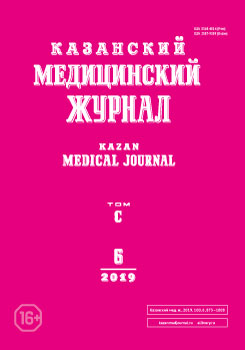The effect of three-component antihypertensive treatment on the structural and functional state of the heart and daily blood pressure profile in patients with hypertension grade 3
- Authors: Azaeva NR1
-
Affiliations:
- Azerbaijan Scientific Research Institute of Cardiology n.a. Academician Abdullaev
- Issue: Vol 100, No 6 (2019)
- Pages: 885-891
- Section: Theoretical and clinical medicine
- URL: https://bakhtiniada.ru/kazanmedj/article/view/17955
- DOI: https://doi.org/10.17816/KMJ2019-885
- ID: 17955
Cite item
Full Text
Abstract
Aim. To study the effect of a fixed combination of perindopril arginine (10 mg) + indapamide (2.5 mg) + amlodipine (5 mg) on the daily profile of blood pressure and the structural and functional state of the heart in patients with hypertension grade 3.
Methods. 80 patients with hypertension receiving various variants of treatment [50 patients (experimental group) receiving fixed combination of perindopril arginine (10 mg) + indapamide (2.5 mg) + amlodipine (5 mg) and 30 patients (control group) receiving combination of lisinopril with hydrochlorothiazide (10/12.5–20/25 mg) and amlodipine (5 mg)] underwent electrocardiography, Doppler echocardiography, daily monitoring of blood pressure at there points: at the beginning, after 2 weeks and 6 months of the treatment. Statistical significance of the indicators was determined by Student’s t-test. To compare the double changes, χ2 was used. Statistical difference between the groups was considered significant if p <0.05.
Results. In 86% of patients from the experimental group, a decrease in systolic blood pressure by 20 mm Hg or more and/or diastolic blood pressure by 10 mm Hg was noted, which persisted for 6 months. After 6 months of treatment, according to daily monitoring of arterial pressure, the average daily systolic and diastolic blood pressure significantly decreased by 15.9 and 18.6% (р <0.001), and the values of variability of average systolic and average diastolic pressure at night and daytime — by 4 and 4.2%, respectively (р <0.001). A decrease in the morning rise rate of systolic and diastolic blood pressure was also achieved (р <0.001). During treatment, a number of patients with a daily curve of the dipper type increased due to a decrease in non-dippers and night pickers (р <0.001).
Conclusion. Positive antihypertensive result after treatment with a combination of perindopril arqinine + indapamide + amlodipin was achieved in the early stages of treatment and was observed as a long-term stable hypotensive effect; a number of patients with normal daily rhythm of blood pressure increased, decrease of the severity of hypertrophy and size of the left ventricle was observed and its diastolic function became normal.
Full Text
##article.viewOnOriginalSite##About the authors
N R Azaeva
Azerbaijan Scientific Research Institute of Cardiology n.a. Academician Abdullaev
Author for correspondence.
Email: nurdoc06@yahoo.com
Azerbaijan, Baku, Azerbaijan
References
- Guidelines for the management of arterial hypertension 2018 ЕSC/ЕSH. Russian Journal of Cardiology. 2018; 23 (12): 143–228. (In Russ.)
- Banegas J.R., Ruilope L.M., de la Sierra A. et al. Relationship between clinic and ambulatory blood-pressure measurements and mortality. N. Engl. J. Med. 2018; 378: 1509–1552. doi: 10.1056/NEJMoa1712231.
- Corrao G., Parodi A., Zambon A. et al. Reduced discontinuation of antihypertensive treatment by two drug combination as first step. Evidence from daily life practice. J. Hypertens. 2010; 28: 1584–1590. doi: 10.1097/HJH.0b013e328339f9fa.
- Ettehad D., Emdin C.A., Kiran A. et al. Blood pressure lowering for prevention of cardiovascular disease and death: a systematic review and meta-analysis. Lancet. 2016; 387 (10022): 957–967. doi: 10.1016/S0140-6736(15)01225-8.
- Stergiou G.S., Alpert B., Mieke S. et al. A universal standard for the validation of blood pressure measuring devices: Association for the Advancement of Medical Instrumentation/European Society of Hypertension/International Organization for Standardization (AAMI/ ESH/ISO) Collaboration Statement. J. Hypertens. 2018; 36: 472–478. doi: 10.1097/HJH.0000000000001634.
- Brunstrom M., Carlberg B. Association of blood pressure lowering with mortality and cardiovascular disease across blood pressure levels: a systematic review and meta-analysis. JAMA Intern. Med. 2018; 178: 28–36. doi: 10.1001/jamainternmed.2017.6015.
- Morozova T.E., Yudina I.Yu. Triple combinations in the treatment of hypertension — a real way to improve blood pressure control. Consilium Medicum. 2017; (1): 8–12. (In Russ.)
- Gupta A.K., Arshad S., Poulter N.R. Compliance, safety, and effectiveness of fixed-dose combinations of antihypertensive agents: a meta-analysis. Hypertension. 2010; 55: 399–407. doi: 10.1161/HYPERTENSIONAHA.109.139816.
- MacDonald T.M., Williams B., Webb D.J. et al. British Hypertension Society Programme of Prevention And Treatment of Hypertension With Algorithm-based Therapy (PATHWAY). Combination therapy is superior to sequential monotherapy for the initial treatment of hypertension: a double-blind randomized controlled trial. J. Am. Heart Assoc. 2017; 6: e006986. doi: 10.1161/JAHA.117.006986.
- Thomopoulos C., Parati G., Zanchetti A. Effects of blood-pressure-lowering treatment in hypertension: Discontinuations for adverse events attributed to different classes of antihypertensive drugs: meta-analyses of randomized trials. J. Hypertens. 2016; 34: 1921–1932. doi: 10.1097/HJH.0000000000001052.
- ESH/ESC Guidelines for the management of arterial hypertension The Task Force for the management of arterial hypertension of the European Society of Hypertension (ESH) and of the European Society of Cardiology (ESC) 2013. J. Hypertens. 2013; 31 (7): 1281–1357. doi: 10.1097/01.hjh.0000431740.32696.cc.
- Sudzhaeva O.A. Unresolved questions of treatment of arterial hypertension and way of their overcoming with use of the fixed combinations of anti-hypertensive medicines. Meditsinskie novosti. 2017; (3): 17–21. (In Russ.)
Supplementary files






